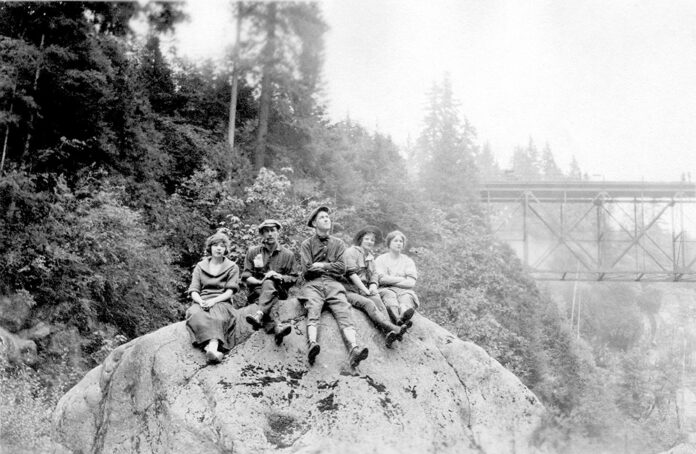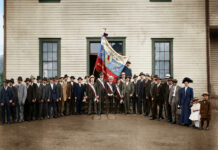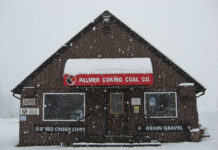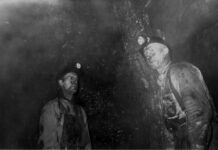Last week’s column featured a photo of two ladies seated on a log that extended far over the rushing waters of the Green River Gorge. This week highlights another among 20 images taken by a party of five during their 1920 road trip from Index to Black Diamond around Labor Day. Three women and two men rest on a huge boulder in the bed of the Green River about 200 feet upstream from what is now a single-lane bridge controlled by stoplights on each end. The Green River Gorge Bridge stands 155 feet above the fast-flowing waters below.
The grandeur of the Green River Gorge has long beguiled visitors. Its charms were first enjoyed by Native Americans long before White settlers arrived in mass following Victor Tull’s discovery of coal in July 1880. By the summer of 1885, the Oregon Improvement Company was shipping coal from their company town named Franklin. Two miles east, the Black Diamond Coal Mining Company shipped its first train loads in December 1884. Both operations tapped the famous McKay seam, perhaps the finest coal deposit in Washington.
By 1904, the Pacific Coast Coal Company had purchased both the Franklin and Black Diamond mines and their associated company towns, which were operated in conjunction with their Newcastle and Lawson workings. The corporate owner, Pacific Coast Company, controlled railroads and shipping lines providing control of their coal from mine to market. Over the next 30 years, Franklin’s mines produced over three million tons of coal.
By 1915, coal’s reign in Franklin was nearly over, although small-scale extraction continued for seven more years. That same year King County built a modern steel-truss bridge across the Green River. Pacific Coast Company began identifying land holdings with development potential. The company marketed sales of Franklin property under the name Pacosco.
Henry Ford’s introduction of the Model T in 1908 revolutionized assembly line production and made automobiles affordable to middle-class Americans. With a newfound freedom in easy transportation, city dwellers soon took to the road in search of rural paradise. They found it at the Green River Gorge where an entrepreneur, Captain Dick Craine purchased 11 acres from Pacosco and developed his resort with a hotel, furnished cottages, clubhouse, tents, and picnic grounds.
Born in Perry, Ohio around 1870, Dick Craine moved to Bellingham at age 17 to work in the logging industry before suffering a knee injury at a sawmill. He next traveled to Alaska as a self-made adventurer – panning for gold, hunting, trapping, trading with Eskimos, and finally operating the Last Chance Roadhouse, Saloon, and Trading Post during the Klondike Gold Rush. While plying the Yukon River in his own steamboat, he gained the nickname Captain.
Further adventures followed including leading a troupe of Native Alaskans that imitated Buffalo Bill’s Wild West show. For a short time, he operated museums in Seattle and Bellingham where he displayed Indian artifacts and Alaskan mastodon fossils. Craine’s first “Eskimo Village” was presented in 1901 at the Pan-American Exposition in Buffalo, New York, and Charleston Exposition the following year.
He then traveled to Europe with a new show, “Alaskan Village” that played at the Crystal Palace in London for six months. Returning to America he staged his show at Madison Square Garden and Chicago’s Coliseum, culminating with its production at the 1904 St. Louis World’s Fair. For the next decade, Craine organized Hiawatha pageants with Ojibwa Indians and performed at numerous Chautauqua summer festivals. Of course, Capt. Craine was the chief showman and lecturer.
After surveying property near the Green River Gorge in 1919, Craine purchased 11 acres from Pacosco to build his resort and display his collection of curios. He often donned the persona of Felix, the Yukon Sourdough, telling Alaskan tales of his interactions with Eskimos and Canadian Ojibwas. Craine and his wife, Bessie (Wilson) constructed Ye Olde Green River Lodge which competed for tourists against Charles Brown’s Falls View Inn, John Rudges’ Green River Gorge Resort, and Frances Stearns’ Vagabond Inn, all surrounded by the natural beauty of the Green River Gorge.
Most of the facilities of the former resorts at the Green River Gorge Bridge are gone, though the 1925 lodge building stands at the east side of the bridge. The surrounding property is private, but parking and access to both sides of the river are available for a $5 donation at the lodge.
This photo comes courtesy of JoAnne Matsumura, an Issaquah historian. Biographical information about Captain Dick Craine was researched by Dr. Richard Feldman, an Indianapolis physician and part-time historian, whose latest book is “What Our Patients Have Taught Us.”







